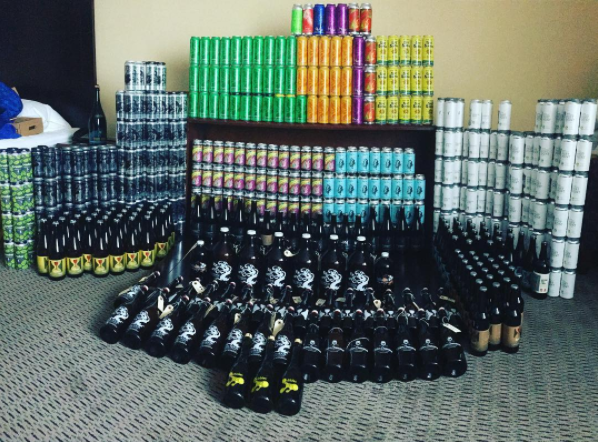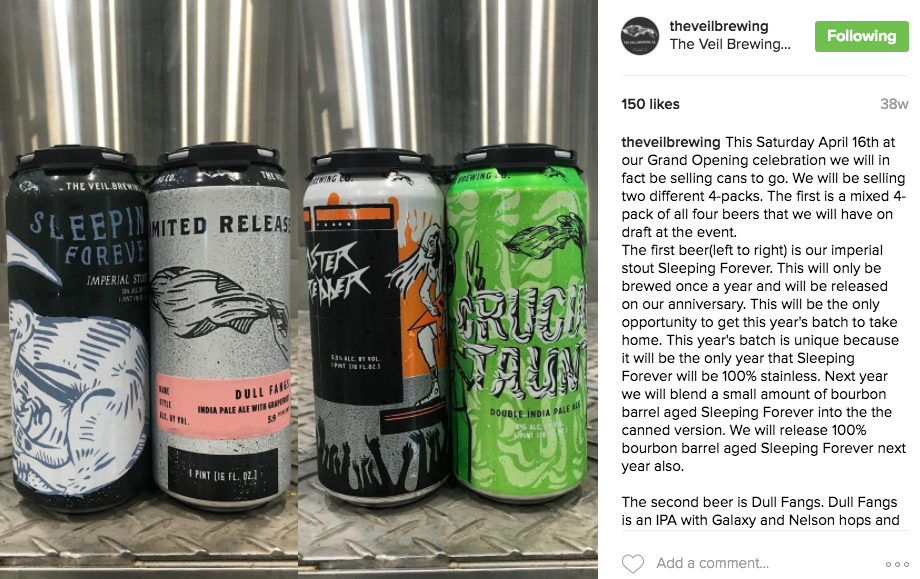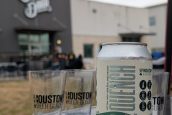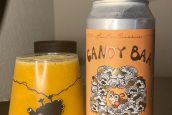Who will be Houston’s Tree House or Trillium?

photo credit: Instagram user @marylandmob
The Northeast-Style IPA Spreads its Wings
Last April, with a good deal of fanfare (at least within beer geek circles), The Veil Brewing Company in Richmond, Virginia, flung its doors open for the first time on a Saturday morning at 11:00 a.m.
Why does this matter to a primarily Houston-based audience of beer lovers? For starters, The Veil wasn’t just another brewery. With previous stints at The Alchemist, Hill Farmstead and more than one apprenticeship at Cantillon, Veil Co-Founder, Co-Owner and Brewmaster Matt Tarpey boasted one of the most impressive CVs ever of anyone opening a new brewery in the United States.
While Richmond, home to both the highly regarded The Answer Brewpub and Triple Crossing Brewing, wasn’t exactly devoid of quality craft beer options, per Good Beer Hunting part of the driving force behind the eventual launch of The Veil was a desire to do as follows:
“import a bit of what was happening in the Northeast down to The River City. People were willing to make the drive up, surely they’d welcome locally made beers of a similar style.”
Ostensibly, Tarpey and co-founder Dave Durrance’s goal was to produce hoppy beer on par with the heavyweights of the Northeast, minimizing the need to have to travel halfway across the country or spend countless hours and dollars arranging trades to acquire the hugely tropical, hazy AF, creamy, soft-bodied canned IPAs taking the beer world by storm (I favor calling them Northeast-Style IPAs, or NEIPA, but New England-Style IPA is also acceptable).

And true to their mission, The Veil came out of the chute guns blazing, boasting not one, not two, not three, but FOUR different canned beers available ON OPENING DAY, with hoppy pales as three of the four offerings, and announced that they would release fresh cans almost every Tuesday thereafter. I don’t follow The Veil closely enough to know exactly how fast their cans move during a given week, but my general sense of it is, if not the day of release, they appear to sell through the bulk of their canned product within a couple of days.
While The Veil is among the more high-profile examples, an increasing number of breweries throughout the country have already implemented or begun to ape this model of ultra-fresh, double dry-hopped, canned IPAs sold almost exclusively on-premise to unreal levels of success. At this point even more casual beer consumers are likely familiar with the stories of how difficult it can be to procure even half a case (if you’re lucky!) of Tree House beers in Monson, MA; how a lengthy line forms weekly in Brooklyn for Other Half Brewing’s canned hoppy delights; and how the weekly can releases at Tired Hands in Ardmore, PA, have gotten so popular that people have lined their empty chairs up in lieu of waiting themselves to try to assure a place in line after they get out of work.
So What Does This Have to do With Houston?
As anyone familiar with my rants on Twitter and occasional essays on the topic knows, I have been at my wit’s end hoping that one of our fine city’s locally-based purveyors of fermented alcoholic beverages would take a shine to the Northeast-Style India Pale Ale.
What does a Northeast-Style IPA taste and/or look like, and why is it any different than a regular old IPA you can buy at the supermarket? I’m so glad you asked. What sets NEIPA apart from its West Coast-style brethren is as follows:
- preposterous amounts of fruit/tropical fruit hop flavor—as a result of the majority of (MASSIVE) hop additions coming late in the boil, post-boil and during the whirlpool PLUS multiple rounds of POUNDS of dry-hopping (sometimes under CO2 pressure)—which generally results in what many refer to as a “juicy” drinking experience (though I’m beginning to tire of seeing “juicy” or “juice” utilized as a descriptor);
- creamy, soft-yet-full bodied mouthfeel (due in part to the specialty grain bill);
- a deeply opaque appearance that can often resemble a glass of orange juice (as a result of the intermingling of the increased hop polyphenol load, proteins and yeast). Haze is not necessarily a critical component of nailing this distinctive flavor profile, BUT in my experience many of the beers that do look like OJ frequently are among the best-tasting in their class; and,
- a citrusy, punchy-yet-pleasant finish that coats the tongue in lupulin lust, resulting in your taste buds sending a signal to your brain’s pleasure center that you will keel over and die from anticipation if you don’t take that next flavor-overloaded sip as fast as humanly possible.

photo credit: @larry_koestler
One of the problems with this beer style is that, once you get a taste of it, it’s really hard to go back. Last year I drank a ton of IPAs, Double IPAs and American Pale Ales from Boston’s Trillium Brewing—in my opinion the finest producer of this style of beer on the planet—which, while resulting in an incredibly enjoyable drinking experience, also comes with significant downsides, as (a) their beer is so flavorful that it makes pretty much anything else available on store shelves in the India Pale Ale category taste like nothing; and (b) being only available at their brewery locations in Massachusetts makes their beer insanely expensive and logistically time intensive to procure for those that do not live nearby.
A Focus, Not an Afterthought
During the past few months a small handful of Houston breweries have released beers that have purported to feature certain techniques and/or ingredients that are hallmarks of brewing the style—though in fairness to these breweries, they haven’t gone quite so far as to explicitly state “this is our attempt at a New England-Style IPA” but rather their own interpretation of such—but in my experience if you’re going to fully nail the flavor profile that’s making all the hopheads swoon, you need to go all the way. And I don’t believe anyone’s gotten there yet. It’s not like I’m expecting Trillium-level exceptionality here—that’s not a realistic standard for any brewery in any city—but I don’t think it’s out-of-line to expect someone at some point to produce a reasonable approximation of the style.
That said, I recently realized that I’ve been looking at this situation the wrong way. I’ve wanted already-existing local breweries in Houston to take a stab at a style that, in all reality and much to my chagrin, probably doesn’t make a whole heck of a lot of sense for them to even try. I applaud those that have done so. If there’s one thing the Houston beer scene has shown, it’s that locals will support almost any brewery and beer that is produced. If there was such a thing as ranking a city’s support for local craft breweries, Houston would probably be number-one in the country. And so if local breweries are already experiencing success without taking a stab at this admittedly very expensive style to produce—and also not being pushed by their patrons to experiment—then from a business standpoint, why fix what isn’t broken?
However, I believe that as Houston beer consumers continue on their hop journey, and are eventually exposed to the insane flavors coming out of areas like the Northeast (and also now across the country; even breweries on the West Coast are starting to abandon their overly bitter Double IPA ways in favor of the new Northeast normal, with Monkish, Mumford, Kings and others leading the charge in the greater LA area), at some point the pent-up demand will be too great. Heck, being an IPA lover in New York City is like being a kid in a candy store with how quickly breweries have gotten onboard the canned hazy IPA on-premise-sale model. Almost none of the breweries now canning even existed three years ago to this day, and none were canning yet. Now on every single weekend in NYC there is at least one guaranteed can sale — at Other Half — with seven(!) other local breweries offering semi-regular on-premise sales — Threes, Finback, Interboro, LIC Beer Project, Greenpoint Beer & Ale. Co, SingleCut and KCBC — not to mention several of the outstanding breweries in the greater NYC area — Peekskill, Rushing Duck, Barrier and Sand City — also providing hyper-fresh absurdly delicious canned offerings. Three years ago, NYC was almost literally Houston with regards to a lack of canned hazy IPAs. Local breweries recognized they could capitalize on hopheads’ willingness to travel great distances to secure their beloved liquids, the market quickly corrected itself, and everyone won. Now my biggest challenge whenever I travel back to my hometown is figuring out how many cans I can realistically fit in our luggage. And this all happened in less than three years!
I have to imagine at some point there will be enough people like me who love hugely hopped IPAs whose needs aren’t being met locally and who are tired of having to import their beer from the Northeast. This will create a significant opening for whichever genius decides to be first to the Houston market with a brewery that makes NEIPA a core if not outright sole focus of their beer program—similar to the way The Veil hit the market in Virginia with canned NEIPA right out of the gate—and not as an afterthought. The absolute, very last thing Houston needs is yet another brewery opening with Ambers, Blondes, and other styles that do nothing to push the flavor envelope.
If You Build It…
I know one of the biggest concerns/impediments to getting this done in Houston is the fact that this style of beer is extremely expensive to make (I’ve also spoken with some folks who are concerned about replicating the water profile of the Northeast, but there’s tons of information available about treating your water to approximate NE-Style IPAs, and I know it can be done because a buddy of mine homebrewed an exact replica of Bissell Brothers’ Swish, one of the finest DIPAs on the planet). I know about the cost firsthand because I am a co-owner of a craft brewery based in New York City—Third Rail Beer—that released an IPA brewed in this vein and it was the most expensive beer we’ve ever produced by a longshot. The cost of the pounds of hops per barrel during the two rounds of dry-hopping frequently employed by the standard-bearers of the style would make Scrooge McDuck blush. As a result of that price, the cost is passed on to the consumer. $16 four-packs of 16-ounce cans has become the norm throughout much of the Northeast and New England. In fact, even a $16 four-pack is starting to become antiquated, as the higher ABV pales dosed with lupulin powder are routinely commanding $18-$22 for four cans of beer.
Now I’m not necessarily suggesting the Houston market is ready for the $20 four-pack (though it might be!). While I would happily pay that for beer that could approximate what Trillium is doing, I recognize that I am outlier. BUT, I’m also not the only one. Houston is a massive city, and while as we have established, the vast majority of beer drinkers locally may not be familiar with the NEIPA style or breweries that make it, there are also a lot of beer geeks in Houston, and that audience is only growing. And yes, a $4-$5 can of beer might be looked at by some as crazy talk, but when you consider the bulk of sales of canned IPAs are taking place on-premise at their respective breweries, cutting out the middleman, I don’t think it’s unreasonable for a new Houston brewery to take a chance on pinning their business model on massively dry-hopped IPAs, putting them into cans, and charging a premium (also, a $4 can remains a great deal when you consider craft pints are now anywhere from $6-$10 in Houston). As long as the beer is very good—and arguably even more importantly, not overproduced (think roughly 200-250 cases per batch)—it’s difficult to envision this model not working.
Two years ago I probably would’ve said the idea of launching a brewery with a business plan calling for the majority of sales to occur on-premise isn’t the most financially sound strategy ever. And while no one should enter the craft beer business expecting to instantaneously replicate what someone like Tree House has done in selling out of every drop of beer they make every week (the best-case scenario by several orders of magnitude), what’s the point of opening a new brewery and feeling like you have to have 10 different styles of what everyone already expects you to be producing, just to keep the doors open? For those who think they need Ambers and Blondes to ensure money comes in the door, in any given week Tree House cans in the vicinity of 2,000 cases of (almost exclusively) the haziest, juiciest, dry-hoppiest IPAs on the planet, and grosses somewhere in the neighborhood of $200,000 per week, all without a drop of liquid touching the distribution tier. Again, ultra-best-case-scenario, but the monetary rewards are there for the individual or team that can pull this style off successfully. One final potential roadblock to launching an NEIPA factory in Houston is the 10,000-barrel limit that comes with a brewpub license (a necessity in Texas to sell on-premise), which I could see some viewing as an impediment, but if anything I think that the limit benefits a style that many agree is best consumed within a month or so of being canned (also, 10,000 barrels isn’t exactly no beer — it’s the same amount currently produced by Tree House on an annual basis, and if a Houston brewery brewing this style hits that production level and is selling out of everything it makes weekly a la Tree House, I’d file that under “good problems to have.”).
Then once they’re established, all this hypothetical NEIPA producer needs to do is release a new IPA or two every week by subtly tweaking the hop varietals utilized and/or dry-hopping schedules (with beer drinker promiscuity at an all-time high, having something new to offer CONSTANTLY is essential; hell, The Veil hasn’t even been open for a year and has a staggering 92(!) beers in the BeerAdvocate database), and watch the money roll in!
People might not initially line up like they do at Other Half, Tired Hands or Tree House, but if the beer is worthy—and available in relatively limited quantities—they will eventually. Someone in Houston just needs to take a “Field of Dreams”-style leap of faith. Even with The Veil’s pedigree there were no guarantees that the people of Richmond would line up for their beers and buy up almost every drop of liquid they put into aluminum every week. But the beer turned out to be great (as of this writing, an impressive 4.2 out of 5 overall average on BeerAdvocate). Jester King has proven that Texans will wait in line (and pay good money and travel) for great, limited beer. “But that’s Austin,” you begin to protest. Yes, it is, but it’s also A LOT of people driving from Houston and other parts of the state to get something that can’t be procured anywhere else. People who love beer will travel for the very best of it — we’re also starting to see this happen with Parish Brewing in Broussard, Louisiana, who not coincidentally have been very candid about their recent switch to a yeast strain popular in NEIPA brewing circles. Even if someone were to set up shop in, say, Katy, beer geeks have shown that they are willing to travel for greatness—and while many may not want to admit it, exclusivity. And that’s a HUGE component of the mania surrounding the NEIPA these days. Not only is selling it on-premise an imperative from a “best enjoyed as soon as possible and away from the inefficiency of the supply chain” perspective, but it also boosts demand by virtue of only being available at the source.
Now, who’s gonna be first?














2 Comments
Pingback
http://www.brittskibeers.com/index.php/tree-house-and-trillium-and-other-ne-dankness/
Pingback
https://halcyondaybreak.wordpress.com/2017/11/16/my-favorite-beers-of-2017/